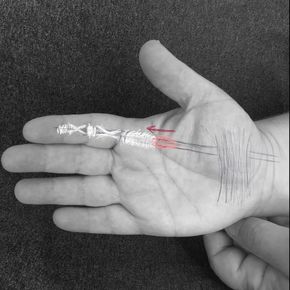Trigger Finger (Tenosynovitis)
What is Trigger Finger (Flexor Tenosynovitis)?
Helpful Links for More Information
- Trigger Finger is the inflammation of the tendon (the cord that attaches muscle to bone) of the muscle that bends the finger as it slides underneath a ligament in the palm at the base of the finger.
- The tendon is surrounded by a fluid-filled sheath that lubricates the tendon allowing it to glide under this bridge easily. When the tendon is inflamed, it cannot slide easily. With enough friction and inflammation, the tendon may stick or catch.
- Symptoms
- Pain and tenderness in the palm just below the location where the finger meets the palm.
- A tender nodule or bump in the palm of the hand below the location where the finger meets the palm.
- A "catching", "clicking", or "popping" of the tendon.
- In cases of more severe inflammation, the finger may stick in the bent position and have to be "popped open" with the opposite hand.
- Use of a hand or finger brace, splint or orthotic at night to hold the finger straight and prevent it from "catching" or "popping".
- Implementing Ergonomic Improvements & Activity Modification
- Avoid repetitive or sustained grasp of objects.
- Avoid forceful grasping of objects.
- Use of Heat and cold
- Use cold packs for acute pain or swelling.
- Use heat packs to control more chronic pain or relax the muscles.
- Wearing compression or Isotoner gloves at night may help control swelling and provide a comforting, neutral warmth.
- Use of a 3/4 finger length gloves with leather or gel padding in the palm (such as weight-lifting or bicycle gloves) while performing activity may provide comfort as well as prevent the tendon from triggering.
- Perform tendon gliding exercises emphasizing the hook, or half, fist. Do not perform any exercise that creates the triggering effect.
- Use of topical pain relieving creams if helpful and as needed.
- Modalities such as ultrasound, electrical stimulation and iontophoresis may be helpful to reduce pain and inflammation.
- Therapeutic taping may be helpful to reduce pain and provide gentle support.
- A short course of anti-inflammatory medications, such as NSAIDs, may be helpful as prescribed by an MD or over-the-counter (Advil, Aleve) if not contraindicated by other medical conditions.
- A Cortisone injection at the base of the inflamed tendon in the palm of the hand may reduce inflammation.
- If conservative treatment methods do not alleviate the symptoms, surgical options may be considered.
Helpful Links for More Information
- American Society of Hand Therapists (ASHT) - PDF Educational Handout
- American Society for Surgery of the Hand (ASSH) -Website Information; Also, provides a link to an informational video as well as a case study video.
- American Association for Hand Surgery (AAHS) - PDF FAQ
- American Academy of Orthopaedic Surgeons (AAOS) - Website Information
- California Orthopaedic Surgery & Hand Institute - a detailed powerpoint/movie presentation
Proudly powered by Weebly
